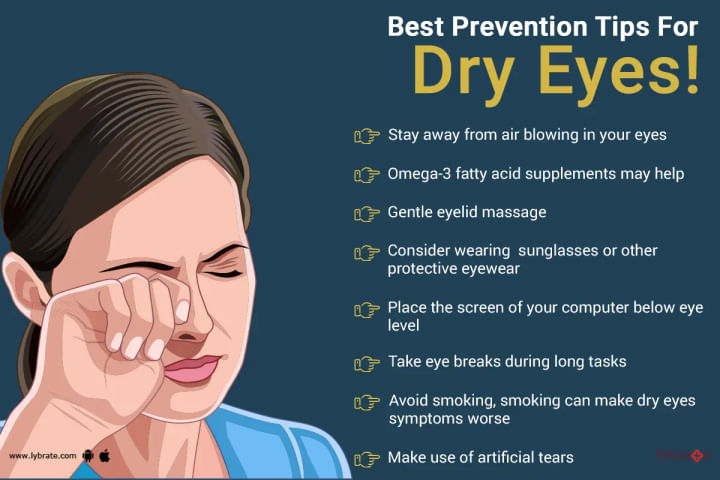Dry Eyes Remedies and Prevention
What is Dry Eyes?
Dry eyes is a condition that occurs when the eye is not able to produce enough tears to maintain a healthy level of moisture and lubrication. This can be caused by a variety of factors, such as age, medications, environmental conditions, or prolonged periods of staring at a computer or electronic device.
Dry eyes can be very uncomfortable and can lead to irritation and redness. If left untreated, it can lead to more serious eye problems such as vision loss and even infection. Fortunately, there are several effective remedies and prevention methods for dry eyes that can help sufferers manage their symptoms and keep their eyes healthy.
What are the signs and symptoms of Dry Eyes?
The signs and symptoms of dry eyes may include:
- Feeling of grittiness, itchiness, or irritation.
- Burning sensation in the eyes.
- Reddening or inflammation of the conjunctiva (the outer covering of the eye).
- Watery eyes as a result of an overproduction of tears due to an attempt to relieve dryness.
- Blurry vision or difficulty maintaining concentration on one task for extended periods.
- Increased susceptibility to eye infections due to weakened tear film protection.
What are possible complications of Dry Eyes?
Complications associated with dry eyes include:
- Eye discomfort, including burning, itching or foreign body sensations.
- Blurred vision due to an inability of the eye to be lubricated properly.
- Increased sensitivity to light and wind exposure due to reduced tear production.
- Eye infections caused by a decrease in immunity that occurs when eyes are lacking sufficient moisture.
- Corneal damage from power issues with contact lenses fitting properly or not being able to wear them due to discomfort; increased risk for ulcers or abrasions on the cornea is also possible if inadequate tears are present on the ocular surface of the eye (known as 'dry eye syndrome').
- Vision-threatening inflammations, such as marginal keratitis, disseminated granulomatous keratitis, and conjunctivochalasis, which can lead to permanent vision loss if not treated properly and promptly.
Dry Eyes Remedies and Prevention
Here are some easy and effective remedies and prevention tips to help control dry eye symptoms:
- Stay hydrated and drink plenty of water: Drinking plenty of fluids helps maintain moisture levels throughout the body, which can help reduce dry eye symptoms. Try to avoid caffeine or any other diuretic drinks as they may cause dehydration, exacerbating dry eye issues.
- Eye Drops: Over-the-counter artificial tears (eye drops) can provide relief for mild cases of dry eye. They also provide a cooling sensation that helps soothe irritated eyes and provide lubrication for daily activities such as reading or working on a computer screen.
- Avoid tobacco smoke: Tobacco smoke has been linked to dry eye syndrome. Inhaling tobacco smoke and secondhand smoking, both of which contain irritants that are found to reduce the amount of tear production in the body, increase risk for developing dry eyes.
- Warm Compresses: Applying warm compresses (like wet cloths) over closed eyelids for two minutes can help increase tear flow naturally by stimulating the meibomian glands (oil glands located at the inside corners of your eyelids that help keep your tears from evaporating). Cold compresses can also help reduce inflammation associated with dry eyes as well as ease discomfort associated with itching caused by allergies or environmental irritants.
- Lifestyle Changes: Staring at screens all day, not getting enough sleep, bad nutrition habits along with air conditioning or frequent air travel all cause eyestrain and contribute to dry eye problems by reducing tear production over long periods of time leading to depleted oil layers protecting your tears from evaporating too quickly resulting in an overall decrease in tear flow from the eyes. So try not to stay focused on one particular thing (like watching TV) for too long. If you do need to use screens for extended periods then try taking regular breaks every hour or so.
- Combat dry indoor climates with a humidifier: Dry air increases the likelihood of dry eye syndrome, so it can be helpful to keep a humidifier in your room to add moisture to the air. Using humidifiers especially during winter months will significantly help you out. Humidifiers restore moisture into the indoor environment reducing friction between cornea surface & eyelids/eyelashes when blinking thus helping minimise any irritation related issues.
- Eat Healthy Fats: Consume more foods that contain omega-3 fatty acids such as cold water fish, walnuts, and flaxseeds. These essential fatty acids can help to lubricate your eyes and keep them hydrated.
- Use an Eye Massage Oil or Gel: Some studies have indicated that using eye massage oil or gel regularly can help increase tear production and decrease symptoms of dry eyes.
- Wear Sunglasses: Wearing sunglasses when outdoors is critical for protecting your eyes from ultraviolet light that can worsen dry eyes symptoms by evaporating tears faster than normal from your tear film layers Shaded glasses can help slow down the process of your tears evaporating while also protecting against sun damage caused by UVA/ UVB rays.
What are the surgical treatments for Dry Eyes?
- Punctal Plugs: Punctal plug insertion is a minimally invasive surgery that can help to reduce or eliminate tear drainage and increase tear production. During the procedure, tiny plugs made of natural substances are inserted in the ducts responsible for draining tears from the eyes. The plugs act as barricades to minimize tear evaporation, thereby stabilizing eye moisture.
- Thermal Pulsation Therapy: Treatment with thermal pulsation therapy (TPT) has been an effective treatment for dry eyes caused due to inadequate glandular function. This is a non-invasive procedure in which infrared pulses of heat are used to stimulate the meibomian glands, which produce lubricating oils. This process helps to improve the quality and functioning of tears in the eyes, thus relieving symptoms like pain, redness and irritation associated with dry eye syndrome.
- Autologous Serum Tears: Autologous serum tears (AST) is a cutting-edge surgical technique and an effective solution for those who suffer from mild or moderate dry eyes. The surgeon harvests blood plasma from the patient's own body – typically taken from their arm – and uses it to create customized artificial tears as drops for relief of symptoms associated with dry eye syndrome. Through this procedure, fewer preservatives are used, thus avoiding reactions and increasing comfort level for patients suffering from persistent conditions such as blepharitis or meibomian gland dysfunction (MGD).
Best doctors to consult for Dry Eyes
- Ophthalmologists: Ophthalmologists are the best doctors to consult for issues related to dry eyes, as they specialise in the diagnosis, treatment and prevention of eye disorders. A comprehensive eye exam will help identify the underlying cause and inform an appropriate treatment plan for dry eyes.
- Allergists: Allergists may also be consulted if symptoms of allergies are present, as certain allergens can aggravate dry eye symptoms or lead to further complications.
- General Practitioner: A visit with a general practitioner is also recommended to rule out any other underlying medical issues that may be causing or contributing to the dry eyes syndrome.



+1.svg)
